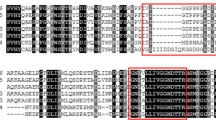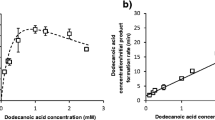Abstract
Cytochrome P4501A (CYP1A) has attracted an increasing interest due to its important role in metabolism of contaminants in aquatic environment and kinds of biomarkers to monitor the pollutants. CYPs are reported to express in E. coli, yeast and insect cells, while expression levels in these systems are too low to continue further study, such as functional and structural research. In this study, we construct an expression system using Shewanella oneidensis to produce goldfish CYP1A. RBS sequence that can elevate expression level by initiating the translation was added. A leading signal peptide which will direct the goal protein into periplasm of the host was introduced. Moreover, large-size plasmid construction strategy was applied during the successful construction process of expression system. At the position of ~60 kDa, a single band was seen clearly after expression; furthermore the amount of expressed CYP1A was as high as 0.02 micromoles per liter in the culture. Heme test was also performed, the result showed the typical P450 hemoprotein spectra. All these data suggest the possible suitable expression system for fish P4501A system was constructed.
Similar content being viewed by others
Change history
12 May 2018
In the 2018 issue of Biotechnology and Bioprocess Engineering (BBE), an error occurred in the research article: Yunqi Ma, Ming Lu, Ziwei Chang, Chu Lee, Hae-Kyun Yoo, and Jang-Su Park (2018) Expression Procedure Optimization of <Emphasis Type="Italic">Carassius aurantus</Emphasis> CYP1A in <Emphasis Type="Italic">Shewanella</Emphasis> Using Plasmid Construction Strategy. <Emphasis Type="Italic">Biotechnol. Bioprocess Eng</Emphasis>. 23: 86-92.
References
Grans, J., J. Johansson, M. Michelova, B. Wassmur, E. Norstrom, M. Wallin, and M. C. Celander (2015) Mixture effects between different azoles and beta-naphthoflavone on the CYP1A biomarker in a fish cell line. Aquatic Toxicol. 164: 43–51.
Colavecchia, M. V., P. V. Hodson, and J. L. Parrott (2007) The relationships among CYP1A induction, toxicity, and eye pathology in early life stages of fish exposed to oil sands. J. Toxicol. Environ. Health Part A. 70: 1542–1555.
Duffy, J. E. and J. T. Zelikoff (2006) The relationship between noncoplanar PCB-induced immunotoxicity and Hepatic CYP1A induction in a fish model. J. Immunotoxicol. 3: 39–47.
Ghosh, M. C., R. Ghosh, and A. K. Ray (2000) Induction of CYP1A by carbofuran in primary culture of fish hepatocytes. J. Biochem. Mol. Toxicol. 14: 204–209.
Goksoyr, A. (1995) Use of cytochrome P450 1A (CYP1A) in fish as a biomarker of aquatic pollution. Arch. Toxicol. Suppl. 17: 80–95.
Husoy, A. M., M. S. Myers, M. L. Willis, T. K. Collier, M. Celander, and A. Goksoyr (1994) Immunohistochemical localization of CYP1A and CYP3A-like isozymes in hepatic and extrahepatic tissues of Atlantic cod (Gadus morhua L.), a marine fish. Toxicol. Appl. Pharmacol. 129: 294–308.
Brammell, B. F., D. J. Price, W. J. Birge, and A. A. Elskus (2004) Apparent lack of CYP1A response to high PCB body burdens in fish from a chronically contaminated PCB site. Marine Environ. Res. 58: 251–255.
Cionna, C., F. Maradonna, I. Olivotto, G. Pizzonia, and O. Carnevali (2006) Effects of nonylphenol on juveniles and adults in the grey mullet, Liza aurata. Reprod. Toxicol. 22: 449–454.
Chaty, S., F. Rodius, and P. Vasseur (2004) A comparative study of the expression of CYP1A and CYP4 genes in aquatic invertebrate (freshwater mussel, Unio tumidus) and vertebrate (rainbow trout, Oncorhynchus mykiss). Aquatic Toxicol. 69: 81–94.
Jonsson, H., D. Schiedek, A. Goksoyr, and B. E. Grosvik (2006) Expression of cytoskeletal proteins, cross-reacting with anti-CYP1A, in Mytilus sp. exposed to organic contaminants. Aquatic Toxicol. 78: S42–48.
Kim, J. H., S. Raisuddin, J. S. Ki, J. S. Lee, and K. N. Han (2008) Molecular cloning and beta-naphthoflavone-induced expression of a cytochrome P450 1A (CYP1A) gene from an anadromous river pufferfish, Takifugu obscurus. Marine Pollut. Bull. 57: 433–440.
Zhang, J., Y. Yang, D. Teng, Z. Tian, S. Wang, and J. Wang (2011) Expression of plectasin in Pichia pastoris and its characterization as a new antimicrobial peptide against Staphyloccocus and Streptococcus. Protein Exp. Purificat. 78: 189–196.
Wang, L., A. C. Camus, W. Dong, C. Thornton, and K. L. Willett (2010) Expression of CYP1C1 and CYP1A in Fundulus heteroclitus during PAH-induced carcinogenesis. Aquatic Toxicol. 99: 439–447.
Wu, Y. D., L. Jiang, Z. Zhou, M. H. Zheng, J. Zhang, and Y. Liang (2008) CYP1A/regucalcin gene expression and edema formation in zebrafish embryos exposed to 2,3,7,8-Tetrachlorodibenzo-pdioxin. Bull. Environ. Contaminat. Toxicol. 80: 482–486.
Lee, Y. M., T. D. Williams, S. O. Jung, and J. S. Lee (2005) cDNA cloning and expression of a cytochrome P450 1A (CYP1A) gene from the hermaphroditic fish Rivulus marmoratus. Marine Pollut. Bull. 51: 769–775.
Oh, S. M., B. T. Ryu, H. R. Kim, K. Choi, and K. H. Chung (2009) Molecular cloning of CYP1A gene and its expression by benzo(a)pyrene from goldfish (Carassius auratus). Environ. Toxicol. 24: 225–234.
Ohno, M., W. S. Darwish, Y. Ikenaka, W. Miki, and M. Ishizuka (2011) Astaxanthin can alter CYP1A-dependent activities via two different mechanisms: induction of protein expression and inhibition of NADPH P450 reductase dependent electron transfer. Food Chem. Toxicol. 49: 1285–1291.
Sambrook, J., E. F. Fritsch, and T. Maniatis (1989) Molecular cloning. Cold spring harbor laboratory press. NY, USA.
Aslanidis, C. and P. J. Dejong (1990) Ligation-independent cloning Of Pcr products (Lic-Pcr). Nucleic Acids Res. 18: 6069–6074.
Bryksin, A. V. and I. Matsumura (2010) Overlap extension PCR cloning: A simple and reliable way to create recombinant plasmids. Biotechniq. 48: 463–465.
Matsuo, Y., H. Kishimoto, T. Horiuchi, K. Tanae, and M. Kawamukai (2010) Simple and effective gap-repair cloning using short tracts of flanking homology in fission yeast. Biosci. Biotech. Bioch. 74: 685–689.
Alves, M. N., S. E. Neto, A. S. Alves, B. M. Fonseca, A. Carrelo, I. Pacheco, C. M. Paquete, C. M. Soares, and R. O. Louro (2015) Characterization of the periplasmic redox network that sustains the versatile anaerobic metabolism of Shewanella oneidensis MR-1. Front. Microbiol. 6: 665.
Salis, H. M., E. A. Mirsky, and C. A. Voigt (2009) Automated design of synthetic ribosome binding sites to control protein expression. Nat. Biotechnol. 27: 946–950.
Lessard, J. C. (2013) Transformation of E. coli via electroporation. Meth. Enzymol. 529: 321–327.
Rachkevych, N., K. Sybirna, S. Boyko, Y. Boretsky, and A. Sibirny (2014) Improving the efficiency of plasmid transformation in Shewanella oneidensis MR-1 by removing ClaI restriction site. J. Microbiol. Meth. 99: 35–37.
Chang, Z., M. Lu, K. J. Shon, and J. S. Park (2014) Functional expression of Carassius auratus cytochrome P4501A in a novel Shewanella oneidensis expression system and application for the degradation of benzo[a]pyrene. J. Biotechnol. 179: 1–7.
Kim, I. C., Y. J. Kim, Y. D. Yoon, S. Kawamura, Y. S. Lee, and J. S. Lee (2004) Cloning of cytochrome P450 1A (CYP1A) genes from the hermaphrodite fish Rivulus marmoratus and the Japanese medaka Oryzias latipes. Marine Environ. Res. 58: 125–129.
Sanders, J. M., L. T. Burka, C. S. Smith, W. Black, R. James, and M. L. Cunningham (2005) Differential expression of CYP1A, 2B, and 3A genes in the F344 rat following exposure to a polybrominated diphenyl ether mixture or individual components. Toxicol. Sci. 88: 127–133.
Mihailovic, M., D. Bogojevic, S. Dinic, N. Grdovic, I. Grigorov, S. Ivanovic-Matic, S. Labus-Blagojevic, V. Martinovic, M. Petrovic, A. Uskokovic, M. Vadakovic, and G. Poznanovic (2006) CYP1A expression in Mullus barbatus and Merluccius merluccius from the Adriatic Sea in Serbia and Montenegro. Bull. Environ. Contaminat. Toxicol. 77: 559–565.
Niwa, H., T. Anzai, and S. Hobo (2007) Construction of a recombinant plasmid as reaction control in routine PCR for detection of contagious equine metritis (CEM-PCR). J. Vet. Med. Sci. 69: 1199–1201.
Brunius, C., M. K. Rasmussen, H. Lacoutiere, K. Andersson, B. Ekstrand, and G. Zamaratskaia (2012) Expression and activities of hepatic cytochrome P450 (CYP1A, CYP2A and CYP2E1) in entire and castrated male pigs. Animal: An Internat. J. Animal Biosci. 6: 271–277.
Barroga, C. F., H. Zhang, N. Wajih, J. H. Bouyer, and M. A. Hermodson (1996) The proteins encoded by the rbs operon of Escherichia coli: I. Overproduction, purification, characterization, and functional analysis of RbsA. Protein Sci. 5: 1093–1099.
Zaitseva, J., H. Zhang, R. A. Binnie, and M. Hermodson (1996) The proteins encoded by the rbs operon of Escherichia coli: II. Use of chimeric protein constructs to isolate and characterize RbsC. Protein Sci. 5: 1100–1107.
Dai, G., T. Sun, L. Miao, Q. Li, D. Xiao, and X. Zhang (2014) Modulating expression of key genes within beta-carotene synthetic pathway in recombinant Escherichia coli with RBS library to improve beta-carotene production. Sheng wu gong cheng xue bao 30: 1193–1203.
Takamiya, S., H. Yamasaki, M. Hashimoto, H. Taka, K. Murayama, M. Tagaya, and T. Aoki (2003) Heterologous expression of Ascaris suum cytochrome b5 precursor protein: A histidine-tagged full-length presequence is correctly processed to transport the mature protein to the periplasm of Escherichia coli. Arch. Biochem. Biophysics 413: 253–261.
Schlegel, S., E. Rujas, A. J. Ytterberg, R. A. Zubarev, J. Luirink, and J. W. de Gier (2013) Optimizing heterologous protein production in the periplasm of E. coli by regulating gene expression levels. Microbial Cell Fact. 12: 24.
Williams, L. M. and M. F. Oleksiak (2011) Evolutionary and functional analyses of cytochrome P4501A promoter polymorphisms in natural populations. Mol. Ecol. 20: 5236–5247.
Roy, N. K., N. Walker, R. C. Chambers, and I. Wirgin (2011) Characterization and expression of cytochrome P4501A in Atlantic sturgeon and shortnose sturgeon experimentally exposed to coplanar PCB 126 and TCDD. Aquatic Toxicol. 104: 23–31.
de Marco, A. (2014) Co-expression and co-purification of antigen-antibody complexes in bacterial cytoplasm and periplasm. Meth. Mol. Biol. 1129: 125–135.
Author information
Authors and Affiliations
Corresponding author
Rights and permissions
About this article
Cite this article
Ma, Y., Lu, M., Chang, Z. et al. Expression Procedure Optimization of Carassius aurantus CYP1A in Shewanella Using Plasmid Construction Strategy. Biotechnol Bioproc E 23, 86–92 (2018). https://doi.org/10.1007/s12257-017-0330-x
Received:
Revised:
Accepted:
Published:
Issue Date:
DOI: https://doi.org/10.1007/s12257-017-0330-x




